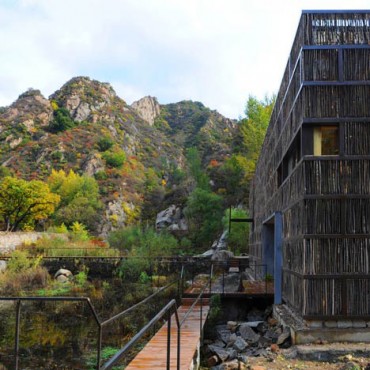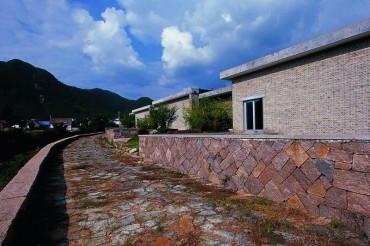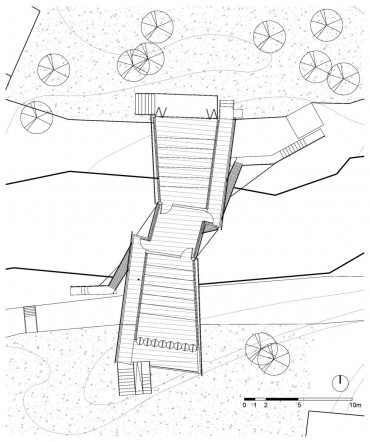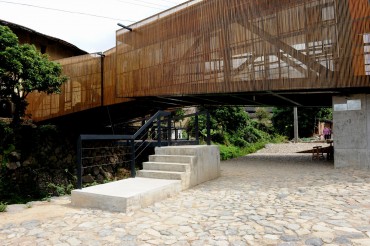
Li Xiaodong. Liyuan library, Huairou (Beijing), 2011

Li Xiaodong. Liyuan library, Huairou (Beijing), 2011

Wang Lu. Tiantai Museum, Tiantai, 2003

Wang Lu. Tourist Center of Changguangxi Park, Wuxi

Li Xiaodong, Bridge School, Xiashi, 2008-2009

Li Xiaodong, Bridge School, Xiashi, 2008-2009
4.3.2013 – Issue 11 - Made In China – Wenyi Zhu, Obiol Cecilia , Xiaodong Li, Wang Lu – Interviews
GLOCAL CHINA
Interview with Wang Lu, Li Xiaodong and Zhu Wenyi
IDENTITY. Could we say that there is a new tendency in Chinese architecture orientated to the recovery of its original identity?
WANG LU. Shortly to say in China we cannot escape from style. After the Cultural Revolution the whole China started to reconsider how to build the so-called Chinese identity, the National style… Now we start to think that globalization and localization is not contradictory.
LI XIAODONG. There is the theory about the center and the periphery. The center produces ideas while the peripheries try to copy these ideas of the center because they want to try to achieve the same standards of life of the center. But what do they do if they copy the idea of the center? If you copy you lose your own ways and you never become a center. That’s what happened to China for the last 30 years, since the early 1980’s. Because there are so many things we can follow, so many things we can copy, so many patterns we can follow…so what happened is that we just adopted this and adopted that and then superimposed in China. For these 30 years is like we tried to learn from everyone outside this country. China became a periphery while the developed countries became centers, which provides the original idea that China tries to follow.
For me identity is not formal, is not iconic. Identity thing is more how we interpret the issue, the problems, it’s a condition. In modern thinking the idea of design is based on one’s logic, one’s thinking…a condition. For the last 30 years we were doing design based on an iconic-formalistic kind of work. We talk about traditional form and modernization, but traditional form has nothing to do with modernization, they are two different concepts.
TRADITION. What is the actual weight of tradition within the current architectural chinese practice?
WANG LU. Not only in China but everywhere people are talking about the tradition and the modernity or the contemporary. In China we have a very long history, and our thinking is very symbolic. We pay much attention to the image, which is in my opinion a key issue in the urbanization and architecture production in China.
Now there is a lot of thinking not merely limited to the image or to the form. Typology, space, material…we have different kinds of approaches.
LI XIAODONG. So that’s Chinese tradition. Tradition is used as a weapon, as a concept, not as a form in the space. The same thing applies to technology. So how can we understand technology not as a separated entity. If we understand first ecology as the human being still as a part of nature; second ecology as for the last thousands of years so we tried to detach ourselves from nature; now it is time to come back not to first ecology but to third ecology. That is we intelligently live with nature. We don’t sacrifice it for our confort but we’re breathing together with nature and consume less resources. So that’s where we should go now.
ARCHITECTURE
WANG LU. Everything used to be developed according to the technique, the climate and also to the lifestyle. But now things have changed. So the important effect on us is how to act in order to face the current situation. What we are now, in which place, in which time.
Now what we are thinking is that with a very low, simple method we are able to consider more things… We can make a very modern layout and this layout is suitable for the contemporary use of space. A new building can look like new and at the same time give the impression that it belongs to the place. You can find that somehow there is nature in there.
LI XIAODONG. That’s the idea of Chinese architecture. The building can be together with the environment instead of standing alone like in western architecture where you draw the building form perspective. European culture, western culture sees architecture as a separate entity. It is an object. Chinese never separate subjects form objects, they are together. That’s why we don’t have a perspective. We see things form a cosmological point of view.
This is Chinese tradition but it doesn’t mean that this tradition can’t be promoted into a new understanding of architecture. So this is what I try. How the building can be part of nature, into the environment, together, in order to create new environments instead of creating an object.
WANG LU is Professor of Architecture and Design of Tsinghua University in Beijing.
LI XIAODONG is Professor of Architecture and Design of Tsinghua University in Beijing.
ZHU WENYi is the Dean of the School of Architecture and Design of Tsinghua University in Beijing.
Interviews by Anna Hotz, Cecilia Obiol and Huang Xuseng during seminar week of the Chair of Prof. Dr. Josep Lluís Mateo to Beijing and Pingyao.
Download article as PDF

